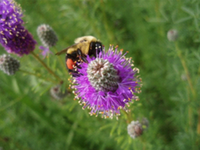Native Plants for Pollinators
The ABQ BioPark is establishing a native plants for pollinators program starting this spring.
By BUGarium Curator Jason Schaller and Assistant Curator of Horticulture Maria Thomas
January 31, 2018 - Native insects that pollinate plants, particularly bumble bees and solitary bees, have become scarcer throughout North America in the past few decades. A combination of excessive pesticide use and habitat reduction has left several species threatened or even endangered. Due to the difficulties in assessing the population dynamics of several hundred different bee species, we know very little about the overall situation. It is possible that species could start disappearing before we even realize they are threatened. Immediate action, such as providing small refuges with suitable nesting sites and native flower plants rich in pollen, and creating public outreach programs to raise awareness of the difficulties pollinators face may be key in conserving these essential insects.
In recognition of these measures, the ABQ BioPark Botanic Garden and BUGarium are working in partnership to establish a Native Plants for Pollinators program starting in spring 2018.
During talks about raising awareness and what we want to accomplish with a pollinator exhibit, it became evident that we should highlight the cyclical relationship between our dependence on pollinators and the native plants that pollinators, in turn, depend upon. With this in mind, we focused on identifying several key species of native pollinator plants that would also fulfill the following criteria: be sustainable in our specific ecoregion (New Mexico has eight), have local cultural significance, be useful in regional land restoration projects, and be aesthetically pleasing to the average visitor or southwest gardener.
These criteria were developed in response to conversations and workshops held over the past year with local herbalists, environmental restoration project managers, monarch specialists, and native seed and plant enthusiasts. From these conversations, it became apparent that there is an absence of native forb (herbaceous flowering plant) seed and plant availability in the local community. Working to fill this niche seemed like the most obvious way the ABQ BioPark could get involved with local plant and pollinator conservation initiatives.
Once we developed a baseline list of plants to start the introductory year with, we sourced the seed from local suppliers and will be growing them this spring in our BioPark greenhouses. A portion of the resulting crop will be used to replant the soon-to-be native Butterfly Pavilion exhibit and surrounding landscape. The exhibit will include interpretative signage that will identify the native forbs and will highlight their significance to the regional ecosystem and local community. The remaining plants will be sold to the public in a spring plant sale.
By releasing the plants for sale into the public with program signage and tags, we will increase both native forb availability and social awareness about environmental issues such as sustainable cultivation and harvest of native plants, the aesthetic value of our fragile desert ecosystems, and the importance of native plants as a pollen and nectar source for regional and migratory insect species.
Moving forward, we intend to expand the program by working with local partners to add unique and rare natives to the list of what we will grow, display and distribute. In addition, future projects will include seed-banking for regional restoration projects and at-risk native plant programs, as well as working with community partners to develop programs for backyard wildlife habitat certification and integrated pest management guidelines for pollinator conservation.
By combining conservation needs from multiple areas in our community, we are striving to develop a comprehensive program that can both enhance the visitor experience as well as contribute to the well-being of our local ecosystems. What began as a single idea, an exhibit displaying native plants for pollinators has grown into a program that has the potential to positively impact a diversity of cultural and ecological communities throughout the region and beyond.


